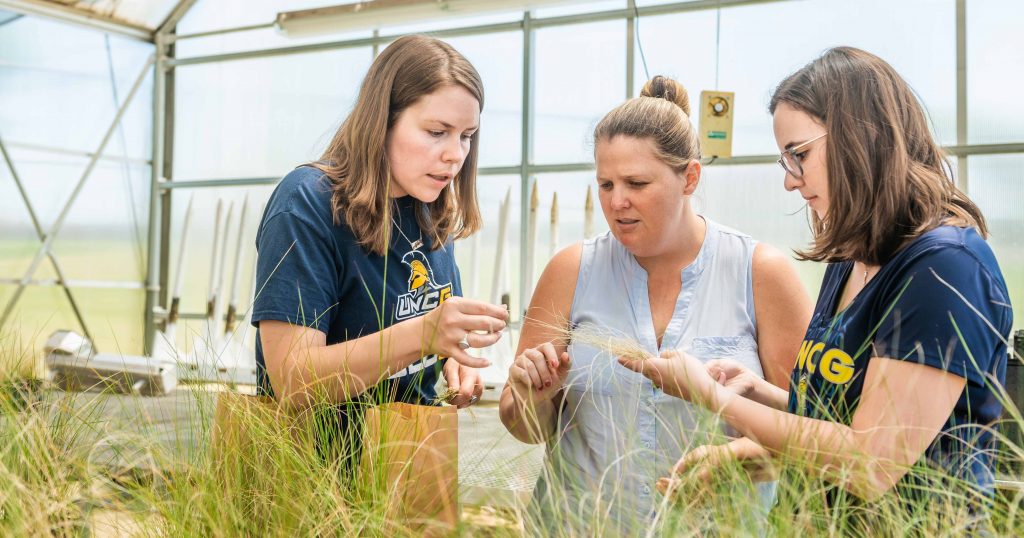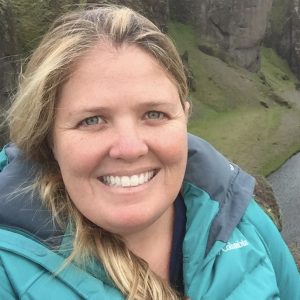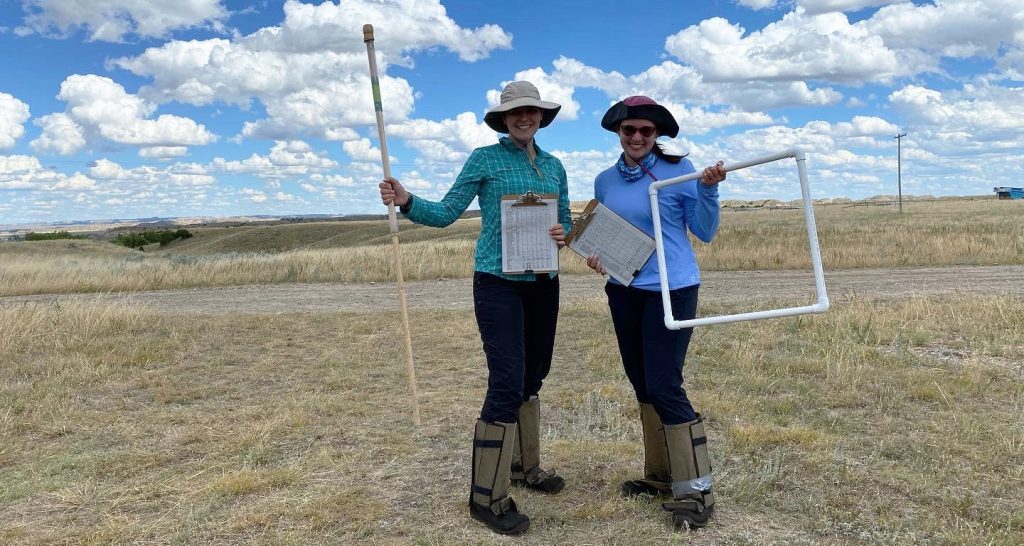Posted on December 21, 2020

Sally Koerner (center) works with students. Photo taken prior to COVID-19 pandemic.
Dr. Sally Koerner is a 2019 Bernard Glickman Dean’s Professor, an honor bestowed on an Assistant Professor in recognition of outstanding research and teaching with promise of continued great success. Her research in biodiversity spans the globe, from South Africa to Montana and Wyoming, to the eastern North Carolina.
In only her fourth year at UNCG, she has been awarded $1.73 million in federal funding for her work, and has produced 37 research publications, many co-authored with her graduate students.
On top of her prolific research program, she has introduced a research module to our core laboratory course for undergraduate majors, BIO 315 Ecology/Evolution lab. This past semester she took nearly 125 undergraduate biology majors to the to see their class research results presented in a professional venue!
Ask a question and design a test to find the answer – experiments are so simple and yet so empowering.
 Most experiments are done in the sterile setting of a laboratory, complete with running water and electricity. But I remember the first time I realized that experiments were not limited to the indoors. I was an undergraduate studying abroad in South Africa. As a class assignment, I was conducting research on how herbivores like zebra impact plant diversity around man-made watering holes in Kruger National Park. The sun was setting over the African savanna, and I could see giraffes and elephants in the distance. I remember thinking, “This is so much better than the lab.”
Most experiments are done in the sterile setting of a laboratory, complete with running water and electricity. But I remember the first time I realized that experiments were not limited to the indoors. I was an undergraduate studying abroad in South Africa. As a class assignment, I was conducting research on how herbivores like zebra impact plant diversity around man-made watering holes in Kruger National Park. The sun was setting over the African savanna, and I could see giraffes and elephants in the distance. I remember thinking, “This is so much better than the lab.”
Since then I have learned the hard way why a scientist would prefer to work inside a lab. I have had rhinoceros destroy my 100-square-foot experimental fences – not one structure, but seven, repeatedly for nearly a decade, before I gave up and moved the experiment. I have had hail the size of softballs destroy an entire experiment of drought shelters the day after I finished setting it up. We have had hurricanes put our experiments under feet of water for days at a time. And I have tried to experimentally impose drought during a naturally occurring drought; it is hard to decrease rainfall when there is NO rainfall!
Yet still, I have never regretted choosing the path of an experimental field ecologist. Ecology happens outside, thus field experiments are critical. The added challenges can also make it fun, and field experiments come with the benefits of sunsets and sunrises, wild mammals, bird songs, and beautiful butterflies. The setting constantly inspires and reminds me why the added struggles are worth it.
As a professor at UNCG, I try to teach my students to embrace the chaos of natural systems, and discover the mechanisms hidden within. And more practically, I hope to teach them three simple things:
1. To plan compulsively but stay flexible,
2. Advanced statistics to account for the uncontrollable the best we can, and
3. To be confident in the fact that nearly everything can be fixed with wire and duct tape (or the next field season).

For many in STEM fields, scientific research consists of lab coats, sterile conditions, and hot plates under a fume hood. However, for the graduate students of the Koerner lab, research looks quite different.
Our experiments start with traveling hundreds to thousands of miles away, and they require us to endure sweltering heat, rain, and even snow occasionally. We build our experiments without power and carry everything by hand so as not to crush the plants we study.
We must be expert planners, outlining every contingency and back-up plan, while maintaining a high level of flexibility, as even the most well thought out plans will, without a doubt, need to be altered. In addition, we must carry with us every potentially needed tool for these contingency plans as the nearest store is frequently more than 45 minutes away. Running out of something simple like Sharpies and zip ties is a great travesty in field work (the greatest being lost truck keys).
When it is time to leave the field, we drive or fly those hundreds or thousands of miles back to UNCG with coolers filled to the brim with soil, insect, and plant samples. Even in the lab, our conditions are anything but sterile. Soil samples fill our refrigerators, jars of insects line the shelves, and endless paper bags stuffed with plant material fill every corner of the lab.
Once the samples are processed, we spend hours poring over code to analyze our data. We fiddle with figures and complex statistics until we get the best understanding of our data. Then, we go back into the field and do it all over again, this time wiser and with a dozen extra sharpies stowed in our bag.
Despite the challenges that our work brings, our experiments are in a setting of incredible beauty. Grasslands are gorgeous landscapes filled with biodiversity. Simultaneously, these ecosystems are vital for carbon sequestration and food security.
As budding ecologists, we get to be at this intersection – where beauty and biodiversity meet function and sustainable use. But we always remember, with all this beauty also comes the occasional 70 mph winds whipping across the plains – and our experiments must be built to endure.